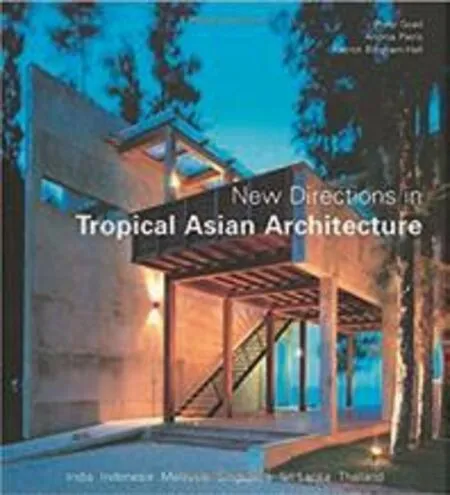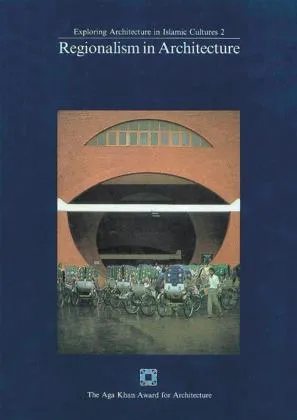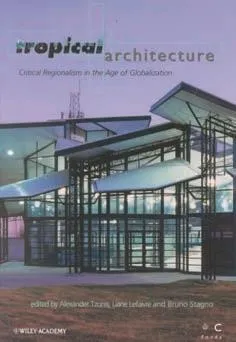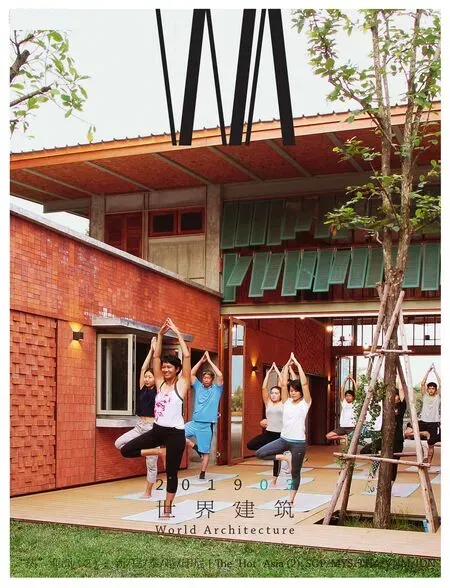亚洲热带建筑
维罗妮卡·吴/Veronica Ng
黄华青 译/Translated by HUANG Huaqing
“热带”作为形容词,常用来描述某个地区或气候的特征。热带地区占据了地球表面上很重要的一部分,但这里的建筑相对而言鲜受外界关注。热带地区广泛分布于世界各地,包括相隔遥远的加勒比群岛、印度、东南亚,以及澳洲、非洲和中南美洲的大部分地区。尽管各地的文化迥异,却拥有相似的气候和生态特征,以及后殖民时代的普遍境遇和全球化时代下的现代化压力。建筑师对热带文脉的回应方式,就和该区域本身一样呈现出多样的风景。
尽管热带地区分布很广,但通常意义上的“热带”建筑主要集中在亚洲范围。热带指向一个具有类似气候条件的区域,具有该气候区所导致的特征的建筑通常就被称为热带建筑。尽管如此,本文仍将讨论“亚洲热带建筑”的复杂性。它将梳理热带建筑的多种面向,强调这个词语的复杂性超越了人们惯常的理解,还可作为一处真实可触的空间、一个概念,以及一种语境。
1 作为实体和现实的热带建筑:热带的特质与影像
过去几十年来,后现代性崛起所标榜的多元性与复杂性概念,导向了多样的建筑实践路径,亚洲热带建筑便为其一。当下,图片的力量借助网站传播,如Archdaily、Contemporarist、Dezeen以及Pinterest这样的网页和应用,为我们打开一个无穷无尽、具有视觉冲击力的影像世界。建筑的视觉投射强化了空间的实体性和现实性。在这些网络平台上,当代亚洲热带建筑的形象表现为本土的,同时又是当代的。因此,热带建筑的形象不仅令人联想到现代建筑的某种杂交体,也回应了特定的气候和文化。
调节热带的日照、风、光和雨的意义,也与更宏大的环境可持续性理念相关。在联合国教科文组织发布的《亚太地区低碳绿色增长指南》中,热带建筑就被视为一种本土而绿色的建筑类型。
“热带建筑可视为一类适用于特定热带气候的绿色建筑,借助设计来最大化地降低建筑能耗、尤其是制冷能耗。热带建筑并非一个新概念。亚太地区的国家早已采用适应于各自气候条件的本土建筑设计理念。例如,高屋顶是为了利用烟囱效应。马来住宅采用很大的屋顶悬挑,西印度群岛则借助凉廊来减少光照受热。这些设计策略让住宅得以在雨季保持开窗通风。萨摩亚人过去并不建造墙体,以促进自然通风。马来住宅的大量窗户也是为了将穿堂风最大化[1]。”
尽管环境可持续性通常局限于建筑科学领域,但热带建筑在建筑领域内借助书籍传播的形象,则是将实体特征描绘为热带的浪漫想象,突显室内外的强关联,让人不免联想到基于传统和文化的建筑。例如,1994年出版的陈复鸣的著作《热带建筑与室内设计:印度尼西亚、马来西亚、新加坡、泰国基于传统的设计》[19]。该书简介中的这段节选就通过照片强调了热带建筑的这种特征及形象:
“本书通过简明的介绍以及大量顶级照片,描绘了一幅关于热带风格的全景画。它完美呈现出热带建筑的感官品质和生动之美,以展现这个世界上文化最丰富的地区之一的建筑。这本书罕见地全面记录了东南亚丰富多彩的优雅建筑及引人注目的室内空间。本书收集了那些天才建筑师与设计师最具魅力的作品。设计的灵感来自于对大地、气候及迷人环境的敬意,夹杂着一股鲜活的传统气息。这些卓越的设计作品既包括造价有限的私人住宅,也包括一些世界上最高端的度假酒店。[19]”
其他类似出版物还包括:《热带亚洲建筑的新方向》[2]《新近马来西亚建筑》[3]《热带风格:马来西亚的当代梦想住宅》[4]《新马来住宅》中收录的当代住宅[5]《重思:马来西亚木构的新范式》[6]《可持续亚洲住宅》中收录的亚洲豪宅[7],还有《热带住宅:重新定义赤道居住环境》[8]。在这些出版物中,亚洲热带建筑的形象大多是浪漫的,空间的感官品质突出,室内外融为一体,由此塑造的形式与热带的日照、风和光之间产生对话,凝聚着强烈的物质性、文化和传统。

1 《热带亚洲建筑的新方向》封面/Book cover, New Directionsin Tropical Asian Architecture

2 《热带亚洲住宅》封面/Book cover, The Tropical Asian House

3 《热带建筑和室内设计》封面/Book cover, Tropical Architectureand Interiors

4 《21世纪热带建筑》封面/Book cover, Tropical Architecture for the 21st Century
Def i nition of "tropical"
a: of, relating to, occurring in, or suitable for use in the tropics
b: of, being, or characteristic of a region or climate that is frost-free with temperatures high enough to support year-round plant growth given sufficient moisture
The notion of "tropical" as an adjective describes the characteristics of a region or the climate. The tropical region covers a signi fi cant proportion of the globe, and yet its architecture receives relatively little outside comment or exposure. Dispersed widely throughout the world, the region incorporates areas as far- fl ung as the Caribbean islands, India, South-East Asia, and large parts of Australia, Africa and South and Central America. Despite their great cultural diversity, these areas share both climatic and ecological factors, as well as a post-colonial condition and the pressures of modernisation in the world of globalisation. Architects' reactions to the tropical context are as varied as the region is diverse.
Despite the wide tropical region, commonly the term "Asian" is synonymous to "tropical". Tropical architecture refers to a region with shared climatic conditions which often results in a plethora of architecturaloutcomes commonly referred to as tropical architecture. While this may be the case,this article discusses the complexity of the notion"Asian tropical architecture" by reviewing the diverse positioning of tropical architecture and highlighting its complexity of the term not only as what is commonly known, but as a physical and real space, a concept and a discourse.
1 Tropical architecture as physical and real:Character and image of the tropics
Since the last few decades, the rise of postmodernity which premised itself on ideas of plurality and multiplicity, has informed a diverse palette of architecturaloutcomes including that of Asian tropical architecture. At present, the power of image via websites such as Archdaily,Contemporarist, and Dezeen and web apps such as Pinterest provide unlimited access to visually powerful images of architecture. The visual-driven projections of architecture reinforce the notion of space as physical and real. These platforms also foreground contemporary Asian tropical architecture as vernacular and at the same time contemporary.As such, tropical architecture is being portrayed as images alluding to hybridisations of modern yet climatically and culturally responsive.
The significance of modulating the tropical sun, wind, light and rain is also linked to the broad notion of environmental sustainability. In the Low Carbon Green Growth Roadmap for Asia and the Pacific by United Nations Educational, Scientific and Culturalorganisation (UNESCO), the notion of tropical Architecture is seen as a vernacular and green building typology.
"Tropical architecture can be regarded as a type of green building applicable specif i cally for tropical climates, using design to optimally reduce buildings'energy consumption, particularly the cooling load.Tropical architecture is not a new concept. Countries in the Asia-Pacific region have adopted vernacular designs adapting to their climatic needs over many centuries. For instance, a high ceiling demonstrates an understanding of the stack effect. Malay homes install a large roof overhang and the West Indians use verandas to reduce solar gains. These design solutions allow windows to remain open for natural ventilation in a building during rainy season.Samoans long ago did not install walls to allow freef low breezes. Malayan homes' plentiful windows aim to maximize cross-ventilation.[1]"
While environmental sustainability is about the science behind buildings, the dissemination of tropical architecture within the fraternity of architecture through books portray the physical character of tropical architecture as imageries of the romantic tropics emphasising a strong connection between outside and inside, and draw links with tradition-based and culturally situated architecture.For example in the book published in 1994 titled Tropical Architecture and Interiors: Tradition-based Design of Indonesia, Malaysia, Singapore, Thailand by Tan Hock Beng[19]. An excerpt of the book's description emphasised the character of tropical architecture and its imagery through photography:
"This book provides concise information and has lavish, superb photography giving a kaleidoscopic vision of the tropical style. It celebrates the sensual qualities and vivid beauty that add up to the tropical architecture of one of the culturally richest regions of the world. It is one of the very few that documents the splendid range of elegantly conceived buildings and remarkable interiors in Southeast Asia. Gathered together in this unique collection are some of the most charming works by talented architects and designers. Inspiration is drawn from a reverence for the land and climate, the enchanting surroundings and a lively sense of tradition. These exemplary works range from modestly budgeted private residences to some of the most exclusive resorts in the world.[19]"
Other examples include publications such as New Directions in Tropical Asian Architecture (2005)[2],Recent Malaysian Architecture (2007)[3], Tropical Style: Contemporary Dream Houses in Malaysia(2008)[4], collection of contemporary houses in the New Malaysian House (2008)[5], Rethink - A New Paradigm for Malaysian Timber (2010)[6], and design showcase of luxury Asian homes in Sustainable Asian Houses (2017)[7]and Tropical Houses:Equatorial Living Redef i ned (2017)[8]. Through these publications, Asian tropical architecture is often illustrated as romantic, sensual qualities of space drawing close connections between the inside and outside resulting in forms that is a dialogue with the tropical sun, wind and light, as well as a strong sense of materiality, culture and tradition.
2 Tropical architecture and the concept of critical regionalism
Besides the physical and real space imagined through tropical architecture, the notion of tropical architecture also has explicit connection to the concept of (critical) regionalism, evidenced through writings of Bruno Stagno and earlier writings of Kenneth Frampton, Alexander Tzonis and Liane Lefaivre's[9,16-17].
In the broader global region, Bruno Stagno,founder and director of the Instituto de Arquitectura Tropical (Institute for Tropical Architecture), argues for communion of building with nature, juxtaposing tradition and innovation. Writing on tropicality in the highly influential volume on tropical architecture, which revived a mid-twentieth-century discourse in the new millennium, Stagno observed:
"Life in the tropics is under the permanent dominion of sensuality. This is evoked by the presence of an exuberant vegetation, under a sky inhabited by capricious clouds; the hammock with its soft swaying; by the importance of the shade that gathers; by the breeze that refreshes and evaporates the sweat of the skin; by the rain, the bracing sun and the multiple mirages. The noises at night come from vigorous nature: the sound of the buds when they blossom, the rustle of animals free and unleashed, the dense, powerful perfume of humidity wafting in the air. The architecture of tropical regions has long been defined in this manner,primarily by contrasting notions of sybaritic indolence and disease-ridden discomfort, extremes derived from the perceived otherness of the tropics to Western culture.[9]"
2 热带建筑及批判地域主义概念
热带建筑除了让人联想到实体和现实空间外,也显著地指向(批判)地域主义的概念。这方面可见于布鲁诺·斯塔诺的论著[9,16],以及肯尼斯·弗兰姆普顿、亚历山大·楚尼斯和利恩·勒费夫尔的早期作品[17]。
在更大的全球范围内,“热带建筑研究院”的创立者及院长布鲁诺·斯塔诺呼吁建筑与自然共享、传统与创新并置。斯塔诺在其颇具影响力的著作 《热带建筑》中论述了“热带性”,这本书在新千年复兴了20世纪中叶的建筑学语境:
“热带的生活始终受到感官的支配。身边的一切皆在唤醒你的感官:繁盛的绿植,变幻无常的多云天空,晃动的吊床,聚集的树荫,唤醒肌肤、吹干汗液的微风,瓢泼大雨,炎炎烈日以及无处不在的蜃楼。夜晚,生命力旺盛的自然传来躁动的声响:花朵悄悄绽放的声音,自由的动物发出的呼呼声,空气中漂浮的湿气混杂着浓郁的香气。热带地区的建筑一直以来就被两种相反的感受所定义,一边是奢侈逸乐的放纵,另一边是疾病充斥的不适,这种极端来源于西方文化对热带他者的一厢情愿的想象[9]。”
布鲁诺·斯塔诺的作品在一个全球化支配的时代,重提批判地域主义的原则。他发展出一套强有力的活动方式,专注于最大化地挖掘热带的气候特征、材料的理性使用、强调景观的热带生物多样性。他也支持在发展中国家的可持续建筑中采取“设计多于技术”的理念。
热带建筑在1980年代的亚洲,化身为多种形式的地域主义建筑[10-11,20]。在1985年的达卡,也就是肯尼斯·弗兰姆普顿的著作、亚历山大·楚尼斯和利恩·勒费夫尔关于批判地域主义的著名论文出版几年之后,阿卡汗奖的伊斯兰建筑项目主办了一场关于这一话题的重要论坛。出席的南亚著名建筑师包括查尔斯·柯里亚、巴克里希纳·多西等,将亚洲视为一种亚文化的集合体,而地域主义是亚洲多元社会共同经历的一次普遍觉醒,只是在不同地点呈现出迥异的形式品质。这些重量级的对谈嘉宾认为,地域主义不应落入固定框架,而应作为一种随着不同社会变化而转变的实践方式,并为城市带来新的空间组织方式。达卡论坛中对地域主义的早期批判性应答也折射出新近的一些学术探索,通过开启地域主义的非固定框架,以更准确地反映支莉莲和陈家辉所谓的热带建筑的“材料多样性和语义丰富性”[12]。这些新近评论将达卡论坛上南亚建筑师提出的挑战带到一个新的层面,为地域主义提出一种标准化、囊括性的概念,延伸了地域主义的内涵,以涵盖那些介入全球化语境或根植于地方环境变迁及城市化进程的思索。
在楚尼斯、勒费夫尔和斯塔诺的著作《热带建筑:全球化时代的批判地域主义》(2001)中,亚洲热带建筑的地位在13章中的5章都进行了讨论[13]:
第五章:挪用的现代化/挪用现代性/陈复鸣
第十章:热带印度的建筑回应/拉胡尔·迈赫特拉
第十一章:绿色议程/杨经文
第十二章:三种热带设计范式/贝·珠华·菲利普
第十三章:重思热带地区的城市:热带城市概念/郑庆顺
尽管在将热带建筑与批判地域主义和全球化联系起来的论著中,本土建筑与文化回应的相似概念被广泛宣扬,但不难发现,创新的主题同样是热带建筑一个重要的驱动力。这便将关于“全球”V.S.“地方”价值及特征的理论探讨引入热带建筑的话语之中。其中涉及的话题包括可持续性、生态及文化多样性、微气候控制技术和多学科设计。
3 作为话语的热带建筑
不仅“热带”这一概念呈现出实体和现实特征,并与批判地域主义的理论相关联,这一名词同样可从权力关系的视角来审视,尤其与对“他者”文化直接或间接的接受相关。热带建筑常被从“热带性”的角度予以讨论。在此便需强调,热带性的观念不仅指向一个实体或现实的空间,同样可视为一个想象的、表征的空间。
有人不免认为这是一种讽刺,即关于热带建筑的书籍和文章往往是从西方中心的视角撰写的。在大卫·贝农近期的一篇文章《热带性、现代性与身份》中,他辩论道,尽管在欧洲殖民时期,亚洲的本土文化受到威胁、削弱或边缘化,但与该时期的负面影响不同,去殖民时期本土文化却在全球化语境下枝繁叶茂[14]。就像当地语言在过去受到限制或禁止之后重新得到普及一样,受到压抑的本地形式表达也在各个层面得到重塑,从国家层面(如印尼、马来西亚)、省区层面(西苏门答腊、沙捞越)到当地层面(多巴巴塔克、卡罗、伊坂)。
来自外部的对热带的认知导致“热带”建筑概念的同质化,亚洲建筑也因此持续被框束在这种他者性之中。“热带”这个概念所定义的建筑处于温和气候建筑的对立面。“热带”的境遇一直以来都是一个西方语境下的转喻,所定义的一种“他者”的气候比起“温和”的西方来说,往往是炎热、潮湿而不适的。无论是殖民时期的建筑折中,还是“热带现代主义”对东南亚地域特征的建筑回应,大多被笼罩在对这种显而易见的恶劣环境的改善语境之下。近期出现的将热带性与后殖民时期亚洲身份及环境可持续性混为一谈的趋势,实际上也来自同一种建构。它进而催发人们的审思:何为亚洲热带建筑的替代路径,那一种替代的热带性又是什么?
贝农以东南亚热带高山地区的当代建筑为例提出,这些建筑产生于“热带”限制条件相对缺席的环境下,同时这里长期存在着自治传统及对平原国家的抵制,这带来一种不那么同质化的热带性阐释。他写道:
“建筑总能呈现出文化关系及相互影响的某段特定历史。很多建筑形式让人联想到某种当地和外来传统的混合物,这篇文章则提出,对于东南亚建筑而言,有些传统受到冷落,另一些则因能够体现外国人更容易理解的热带性原则而得到偏爱。尤其是,东南亚建筑中汇聚的空间、材料和象征因素并不能简单地用外来的热带气候舒适性概念来解释,由此本文提出一种不那么同质化的、对建筑热带性的解读路径[14]。”
在《走向热带建筑谱系:英国殖民地的权力——知识、建成环境与气候的历史碎片》(2011)一书中,张嘉德和安东尼·金以一种福柯式的方法梳理了热带建筑的谱系表。他们认为,热带建筑的概念是基于英国殖民地的权力关系。这个谱系并未将外在的热带自然条件作为热带建筑的首要决定因素,而是督促我们反思决定“热带建筑”的“自然”——它是什么,是谁定义的,在何种历史语境下,为何如此。在迎合这种自然观念的同时,有什么其他知识和实践被掩盖了[15]?这对今天而言极具启发意义,尤其是看到热带建筑越发被笼罩在可持续性的霸权语境之下。
除了其他学者已介绍过的重要建筑及建筑师外,该书还关注了那些较少受到研究的20世纪中叶的热带建筑,尤其是借助研究和教育手段的知识生产及传播。该书在结尾处简要回顾了1970年代初以来热带建筑的重生,尤其关注当下的热带建筑。作者认为,今天的热带建筑裹挟着片段化的历史意涵。在历史谱系中出现过的核心主题及概念——如自然、技术科学、政府治理及社会网络——依然以一种变异的形式重现于今天的热带建筑中。
这种以热带性概念来定义热带建筑的方式,也见于支莉莲和陈家辉提出的非永恒或凝滞的“动态”概念。他们认为,当下人们对热带建筑的理解过于简单化,并未对其话语及伴随而来的议程的多样性予以足够关注。热带性所伴随的概念并不是先验的,而来自一系列切身实践及具体境遇。热带性这样的说法是一种与自然逆向而行的政治化路径。因此,热带建筑看似生发于自然环境,实则为种族、性别和阶级定义的各种权力网络塑造下的一种复杂文化建构。该书反对将热带的建成环境本质化,而试图批判这些关于热带建筑的现存话语——抑或将其视为毫无疑问的、与当地气候及传统相关的本质主义或怀旧主义,或是将其形式客体化为一种仅供被动消费的异域物品。该书的作者试图重新审视,热带空间作为一种记录的或叙述的格式,如何能够作为一种批评模式,同时/或者能够改变我们理解热带性的方式[12]280。
His work embodies the principles of critical regionalism in a time where globalisation is the dominant force. Bruno Stagno has developed an intense activity, focusing on the maximum exploitation of climatic characteristics of the tropics, logical use of materials, and emphasising on tropical biodiversity in the landscape. He endorses the concept of "more design than technology" for sustainable architecture in developing countries.
Tropical architecture was reincarnated as various forms of regionalist architecture in Asia in the 1980s[10-11,20]. It was in Dhaka in 1985, in fact,a few years following the publications of Kenneth Frampton's, and Alexander Tzonis and Liane Lefaivre's seminal essays on critical regionalism,that the Aga Khan Program on Islamic Architecture presented a major seminar on the topic. The leading South Asian architects in attendance -including Charles Correa, Balkrishna Doshi and others - conceptualised Asia as a composition of subcultures, and positioned regionalism as a kind of general consciousness wending through the many realities of Asia's diverse societies, taking on different formal qualities given the locality. Rather than fixed categories, the seminar participants argued in favour of regionalism as a practice that transforms along with changes in society, and projects new formalorganisations of the city. This early critical response to regionalism at the Dhaka seminar reflects more recent scholarly efforts at opening up the discursive categories of regionalism to more accurately reflect what Lilian Chee and Jiat-Hwee Chang call the "material diversity and semantic density" of tropical architecture[12].These more recent critiques take up the challenge posed by the South Asian architects in the Dhaka seminar to a normative and generalisable idea of regionalism and extend the meaning of regionalism to be inclusive of speculation through both engagement with global thematics and local environmental processes and urbanisation.
In Tzonis, Lefaivre and Stagno's writing in Tropical Architecture: Critical Regionalism in the Age of Globalization (2001), the positions on Asian tropical architecture have been discussed in fi ve out of thirteen chapters[13].
· Ch. 5. Modernising Appropriations/Appropriating Modernity/Tan Hock Beng
· Ch. 10. Architectural Responses in Tropical India /Rahul Mehrotra,
· Ch. 11. The Green Agenda/Ken Yeang,
· Ch. 12. Three Tropical Design Paradigms/Bay Joo Hwa Philip
· Ch. 13. Rethinking the City in the Tropics: the Tropical City Concept/Tay Kheng Soon
Although similar aspects of vernacular architecture and cultural responsiveness have been propagated in the publications that links tropical architecture to critical regionalism and globalisation,it is observed that theme of innovation appears strongly as a generating force of tropical architecture.This brings the theoretical discussions on global versus local values and character into the conversations on tropical architecture. Among the issues covered are sustainability, bio- and cultural diversity, micro-climatic control and technology and multi-disciplinary design.
3 Tropical architecture as a discourse
While the notion of "tropical" has been presented as physical and real, and linked to the concept of critical regionalism, the term is also argued from the perspective of power-relations,particularly relating to the acceptance of "other"foreign civilisation either direct or indirect. Tropical architecture is discussed from the perspective of"tropicality". It is apt at this juncture to highlight that the notion of tropicality refers to the view where the tropics being conceived as an imaginative and representational space as much as it is a physically located or real space.
One would think, is it ironic that the books and articles on tropical architecture is usually written through a Western-centric view on the tropics. In the recent writing of David Beynon on Tropicality, Modernity and Identity (2017), he argued that, unlike the adverse impacts caused by European colonisation, during which many aspects of vernacular cultures in Asia were threatened,reduced, or marginalised, decolonisation saw a proliferation of the local within the global[14].Much in the same manner as local languages that were previously restricted or prohibited in their use have gained popularity, repressed local forms and expressions legible in architecture are being remade at a variety of levels, from the national(e.g. Indonesian/Malaysian) to the provincial (West Sumatra/Sarawak) to the local (Toba Batak/Karo/Iban).
The perception of tropics from the outside leads to homogenisation of the idea of "tropical"architecture, by which architecture in Asia continues to be framed within this otherness. The term tropical was a concept de fi ning architecture that was antithesis to architecture of the temperate climate.The "tropical" condition has long been established as a Western trope that defines the "otherness" of climates perceived as hot, humid and uncomfortable compared to the "temperate" West. Both colonial adaptations and "Tropical Modernist" architectural responses to Southeast Asian locations were primarily framed in terms of their amelioration of this apparently hostile environment. That the more recent conflations of tropicality with postcolonial Asian identity and environmental sustainability remain within the same construct leads to questions not only of what architectural alternatives there might be, but also what alternative tropicalities there might be.
Using contemporary buildings in Southeast Asia's tropical highlands, Beynon argued that as the architecture is produced in the relative absence of "tropical" imperatives and the presence of longstanding traditions of autonomy and resistance to lowland state formations; it offers a less homogenous reading of tropicality. Beynon argued:
"All architecture represents particular histories of cultural relations and inf l uences. Many forms of architecture evoke a mixture of local and imported traditions, and this paper will argue in relation to Southeast Asian architecture that some of these traditions have been de-emphasised in favour of others that seem to embody principles of tropicality understandable to outsiders. In particular, it will argue that the confluence of spatial, material and symbolic aspects in Southeast Asian architecture cannot simply be reduced to those that relate to imported ideas of comfort within a tropical climate,and so suggest less homogenous readings of tropicality in relation to architecture. [14]"

5 《建筑中的地域主义》封面/Book cover, Regionalism in Architecture

6 《热带建筑:全球化时代的批判地域主义》封面/Book cover,Tropical Architecture: Critical Regionalism in the Age of Globalisation

7 《热带地区的建筑师》封面/Book cover, An Architect in the Tropics
4 结论:重思热带建筑
近期一些关于热带建筑的研究拓展了热带建筑的认知和定义。在当下的后现代语境下,异质性、多元性更优于同质性、单一性,福柯式的理论方法指向了一条理解所谓“热带”建筑的新途径。
今天我们应超越将热带建筑作为一种建筑形象、一种建筑风格或一种建筑特征的观念——这基于热带地区的实体属性及环境与文化背景,热带建筑的观念不仅是后殖民语境下的一种同质化的西方概念,它的理念化同样根植于这样一种语境:即视为一个由实体物质和建筑、多元的思想和语言、相互竞争的文化想象与意识形态所共同糅合而成的复杂网络。
重新定义热带建筑的趋势,并不止存在于学术研究领域。例如,最近一些年轻建筑师的访谈就折射出类似的思想线索。在(新加坡)国内,雅安·福兰对“与环境共存”的考量体现在他对空调使用的节制上,以此探索热带建筑的特征——他定义为“室内和室外之间没有边界”。他热切地拥抱在新加坡获得的机遇,“我看到很多年轻建筑师试图重新定义热带建筑。我也想成为其中一份子。”[18]
那么,这些都意味着什么?在我看来,有必要从系谱视角重新思索和定义热带建筑。作为一名世界观意义上的后结构主义者,我看到一个拓展热带建筑研究的积极方向,即观察当下这种离散的条件如何催生当代热带建筑的涌现。或许,是时候将热带建筑视为一个多学科框架内变化不定的客体、概念及语境,它正在借助当代建筑实践而逐步生长。□
In the publication Towards a Genealogy of Tropical Architecture: Historical Fragments of Power-knowledge, Built Environment and Climate in the British Colonial Territories (2011), Chang & King wrote about the genealogy of tropical architecture,which is very Foucauldian indeed. They argued that the concept of tropical architecture is based on power-relations in the British colonial territories.Instead of privileging external tropical nature as the prime determinant of tropical architecture, this genealogy urges us to re fl ect upon the "nature" that"tropical architecture" was determined by - what is it, according to whom, under what historical circumstances, and why. By appealing to such a notion of nature, what other knowledge and practices are being concealed?[15]This is especially pertinent today when tropical architecture is associated with a hegemonic discourse of sustainability.
Besides looking at key buildings and architects that other scholars have already explored, the book also looks that the much less researched aspects of mid-twentieth century topical architecture,specifically issues of knowledge production and circulation through research and education. He ended the book with a short re fl ection on afterlives of tropical architecture after the early 1970s,focusing particularly on tropical architecture in the contemporary world. He argued that tropical architecture today carries historically sedimented meanings. Key themes and concepts that appeared in the genealogy - such as nature, technoscience,governmentality and network - recur, albeit in mutated forms, in today's tropical architecture.
This way of conceptualising tropical architecture through the notion of tropicality was also positioned by Chee & Chang as a concept "in-motion" rather than a finite and stagnant concept, arguing that tropical architecture as currently understood is oversimplified and insufficiently attentive to the diversity of discourses and attendant agendas. The meanings associated with tropicality are not a priori but, rather, grow from sets of bodily practices and situational contexts. Tropicality in such terms is a politicised approach as opposed to something natural. Thus, tropical architecture, which seems to connect with and connote the natural environment,is conversely a complex cultural construction that has been subjected to various networks of power marked by race, gender and class. Rejecting the essentialisation of the tropical built environment,the papers attempt to critique existing discourses of tropical architecture that have defined the field as unchallenged essentialist or nostalgic in relation to local climate and tradition, or alternately objecti fi ed its forms as exotic artifacts for passive consumption.Contributors reconsider how tropical spaces in their documented or narrated formats may operate as modes of criticism and/or transform the ways in which we understand tropicality.[12]280
4 Conclusion: Re-thinking tropical architecture
The more recent studies on tropical architecture have broadened the perception and conception of tropical architecture. In the current post-modern context where heterogeneity and multiplicity is favoured over homogeneity and singularity, the Foucauldian approach towards understanding an idea or concept is an alternative means to understand the notion we call "tropical" architecture.
Beyond the perception of tropical architecture as an image, a style or a character of architecture which is based on it physical attributes and the environmental and cultural setting of the tropics,the notion of tropical architecture is seen as a homogenous Western idea within the post-colonial contexts and it is also conceptualised from a discourse, i.e. seen as a complex web of material facts and buildings, discursive ideas and their languages,as well as competing imaginations and ideologies.
The trend towards re-defining tropical architecture not only resides within scholarly research. For example, an interview with a young architect reflect similar line of thinking; in the domestic realm, Follain's concern for "living with the surroundings" sees him discouraging the use of air conditioning and exploring tropical architecture,which he defines as "having no boundary between inside and outside." Embracing the opportunities of his new home country, he adds, "I see a trend among young architects to rede fi ne tropical architecture. I would like to be part of that.[18]"
So, what do all these mean? For me, it means that there is a need to re-think and re-de fi ne tropical architecture from a genealogical point of view. Being a post-structuralist in worldview, I see a positive light in extending the research and study on tropical architecture and how the discursive conditions,enable the emergence of contemporary tropical architecture. Perhaps, it is time to view the notion of tropical architecture as a mutable object, concept and discourse within multidisciplinary contexts, enabled through contemporary practice of architecture.□

